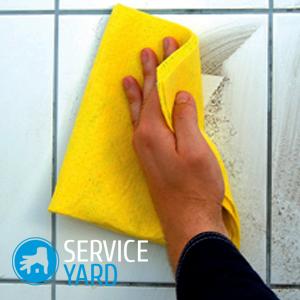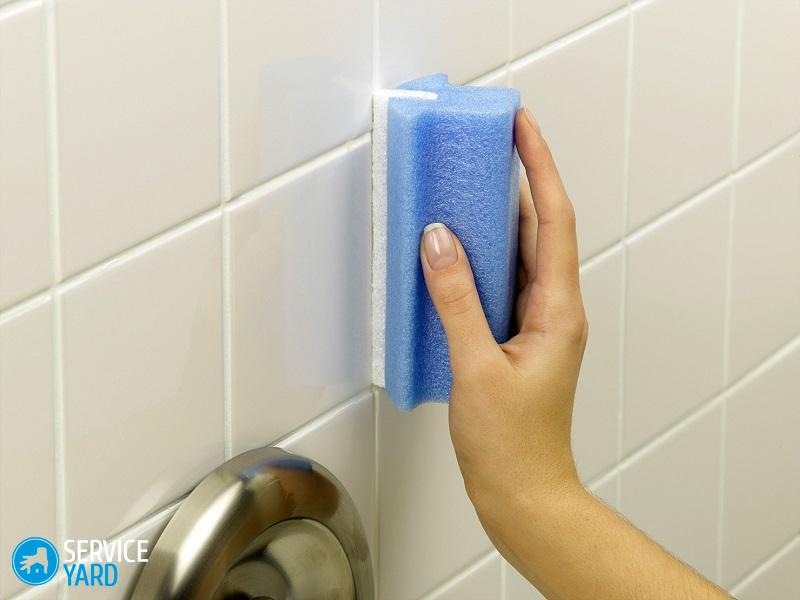How to clean the tiles in the bathroom?

Tile is a traditional material that often covers the walls and floor in the premises of residential apartments and houses. Its main feature is attractiveness, practicality and durability. However, this material requires special care, so you need to know how and how to clean the tiles in the bathroom from plaque, remove stains from water and detergents, and also restore the pristine radiance and shine to it. Due to the observance of the basic rules of operation and maintenance of tiles, each housewife can achieve its maximum durability and aesthetic appeal. Consider the different cleaning options in this article.
to contents ↑Popular types of pollution and their causes
First of all, for quick and thorough cleaning of tiles in the bathroom from plaque, mold and fungus, we need to find out the nature of their origin.
In rooms for maintaining personal hygiene regularly use water that releases steam. It is the vapor deposited on the walls that leave calcareous and saline deposits, which subsequently form unpleasant stains.
Important! Such contaminants are usually represented by light smudges and have a rough structure. Accumulating and drying on the surface, they turn into lime, which is quite difficult to clean.
However, the most severe and dangerous for human health pollution are old mold or fungus. Such problems may appear in your premises for one of the following reasons:
- accumulation of dirt in the inter-tile joints;
- high moisture content in the air;
- heat;
- constant contact with water;
- favorable conditions for the propagation of microorganisms;
- lack of constant and systematic care using antiseptic agents for washing tiles in the bathroom.
If mold or plaque is found that can adversely affect not only the appearance of the ceramics in your bathroom, but also undermine your health, households must urgently proceed to eliminate them.
to contents ↑How to get rid of old mold and unhealthy fungus?
If the coating of fungus or mold is not old, then to clean the gaps between the ceramic base, you can use antifungal solutions, which are enough to apply on the affected area and wait about half an hour. After this treatment, the tiles must be thoroughly washed with clean water and wiped dry with a sponge.
to contents ↑Important! If you do not have a special cleaning agent, then ordinary bleach or baking soda, which also eliminates an unpleasant odor, will help you to wash the tiles in the bathroom.
Folk remedies
Almost every housewife wonders how to clean the tiles in the bathroom from plaque. However, despite the popularity of modern chemicals, most women still give time-tested folk methods.
The following remedies will help you eliminate lime deposits or stains on the ceramic coating:
- Lemon - to clean the tiles, you need to take a small slice of fresh lemon and rub it with the problem area.You can also add lemon juice to the water, which you plan to carry out wet cleaning in the bathroom. After washing the tiles, your room will not only be filled with an invigorating, pleasant aroma of citrus, but it will also appreciate its cleanliness.
- Soda with vinegar is an excellent tool for washing tiles in the bathroom, which will allow you to destroy various deposits and dirt at home. The reaction that occurs when these two substances are mixed softens lime and other deposits. First, soda is applied to the tile, after which the surface is covered with a solution of acetic acid using a spray. Finally, after undergoing a chemical reaction, this combination is removed with a damp cloth.
- Ammonia will not only help remove plaque, but also eliminate oily contaminants. To achieve the highest quality result, dilute alcohol in water and apply to a contaminated surface.
- Chlorine When working with this substance, it is necessary to protect the hands and respiratory system from the negative effects of the solution, so surface treatment must be carried out using protective gloves and a respirator. When using chlorine, calcareous deposits are well removed, but its use can damage ceramic tiles and discolor joints.
to contents ↑Important! Before using chlorine to clean the tiles, test the substance on a separate tile or inconspicuous part of the wall.
How to wash the tiles after the repair is completed?
Having completed the repair, most of the owners of the room are wondering how to clean the tiles in the bathroom from the remnants of the installation material. Most often, we have to deal with the following contaminants:
- silicone sealant;
- building cement;
- grout;
- mounting dust;
- lime;
- paint;
- construction foam.
Depending on the type of contamination present on the surface, it is necessary to choose the most effective cleaning agent.
Glue or silicone sealant
If, after finishing the repair, you need to clean the tile from glue, then you need to be patient and persistent, because the cleaning procedure will be far from easy. To achieve the desired result, follow these recommendations:
- If you find traces of a still soft solution on the surface of the tile, then the best way is to clean it directly during masonry. To do this, a simple rubber spatula or a damp cloth is suitable for you.
- Hardened dirt from silicone sealants can be mitigated with ammonia or vinegar. Acetone is perfect for polymer masses.
Important! Tile cleaning should be done very carefully so as not to damage the surface.
- Chemical effect - silicone sealant is removed using a special tool, which is based on a solvent.
- Mechanical grinding - softened sealant can be removed with a hard sponge or spatula.
Primer and cement
You can remove the white spots of cement and primers remaining after repair on ceramics by applying the following means:
- special washes;
- construction foam;
- acetone.
Important! It is easy enough to remove the primer or cement from the surface of the tile using a scraper with a sharp blade. However, you should be extremely careful not to damage the ceramic tiles.
Grout
If after the repair is completed your tiles left traces of grouting - this is not scary. Removing them is much easier than traces of cement or primer. To clean the floor and walls will be very simple, if after drying the grout, wash them with plain water.
It's much harder to handle an epoxy solution. If a drop of substance has got on the ceramics, then the most practical solution will be to purchase a special solvent and not to suffer.
to contents ↑Important! To avoid such contaminants during operation, use a film or masking tape.
Contamination Prevention
Maintaining perfect order in the bathroom will allow systematic washing of ceramics. Wipe walls and floors with dry and soft cloths. Drips or limescale, due to this, will not turn into dried-up drops that are unaesthetic in appearance.
If you want to return the material a shiny appearance, then you can use a glass cleaner or any other detergent with a non-aggressive chemical composition.
to contents ↑Important! You can’t find a better way to clean the joints between the tiles than using a solution of water with chalk.
Specialized detergents
In any hardware store you can choose from a huge amount of cleaning agents. But acquiring them, you should adhere to the following recommendations:
- choose liquid or creamy cleaning agents, because the cleaning powder can leave small scratches on the surface of the tile, which will cause the loss of its aesthetic appeal;
- chlorine-containing compounds are able to remove contamination and disinfect the room, however, they can damage the ceramic surface;
- compositions containing chalk are not recommended, since after their use often stains remain;
- not suitable for cleaning walls and ceilings from tiles, cleaning compositions containing alkali and acid, which can harm tile joints;
- You should also refrain from buying organic solvents.
Stock footage
In this article we told you how to clean the tiles in the bathroom from various contaminants using folk methods and household cleaning products. To avoid severe contamination of the ceramics, it is enough to care for it daily. This process will prevent unnecessary, unnecessary, time and material costs.
- How to choose a vacuum cleaner taking into account the characteristics of the house and coatings?
- What to look for when choosing a water delivery
- How to quickly create comfort at home - tips for housewives
- How to choose the perfect TV - useful tips
- What to look for when choosing blinds
- What should be running shoes?
- What useful things can you buy in a hardware store
- Iphone 11 pro max review
- Than iPhone is better than Android smartphones



